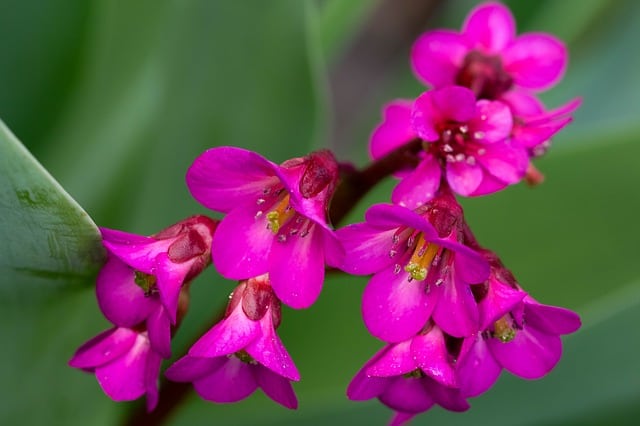Bergenia is a plant native to Central Asia, Afghanistan, China, and the Himalayas. They are perennial, clustered, rhizomes with spirally asterisk leaves 6–35 cm long and 4–15 cm wide. The flowers of this plant are pink, arranged in clusters that look very eye-catching.
So many gardeners love to plant Bergenia in the garden or in front of the house to create an eye-catching landscape. However, many people wonder about has to do with the flowering of this plant.
Why doesn’t my Bergenia flower? Even the maturation time of the tree is larger than usual. How to stimulate Bergenia to flower? Let’s find out more information in the article below.
Why Doesn’t My Bergenia Flower? Top 4 Reasons
As you know, if the plant is not blooming, as usual, it is definitely having growth problems. There are many different reasons why Bergenia does not bloom despite being mature. Some of the underlying causes are lack of light, unsuitable soil, too much fertilizer, and lack of water.
Lack Of Sunshine
One of the most common reasons Bergenia doesn’t bloom is lack of light. This perennial will thrive in full sun or partial shade. However, it needs at least 4 hours of full sun each day.
So if your Bergenia doesn’t get enough sun, it won’t be able to bloom due to problems with photosynthesis and oxygen exchange in the plants. To stimulate flowering, you can move Bergenia to an area with more sun each day and watch it change.

Unsuitable Soil
Soil is one of the three most important factors for plant life and development. Plants will not be able to flower or grow normally on soil that is not suitable for it.
Bergenia will grow well in moist, humus-rich, and acidic soil. Therefore, you need to test the pH of the soil to add some substances to neutralize the pH level in the soil.
If your soil is too alkaline, you should add some organic matter or peat moss to lower the pH. Alternatively, you can also water with rainwater or diluted white vinegar to lower the pH of the soil. Therefore, Bergenia is likely to bloom shortly.
Lack Of Water
Lack of water is another common reason why Bergenia cannot bloom because there is not enough water in the growing process. This plant prefers moist, well-drained soil, so a lack of water causes prolonged drought that prevents this plant from blooming.
Lack of water makes it impossible for the roots to transport enough water to nourish the stem and leaves. Meanwhile, if your plants are exposed to the sun for many hours a day, water evaporation will increase. Therefore, Bergenia will show signs of stress and will not be able to flower.
Some signs of water deficiency such as wilting leaves, yellowing leaves, drooping leaves, dry soil, and no young shoots appear. When there are these signs, you need to water them immediately. Water a lot the first time, water slowly to let the water seep into the soil, and continue watering until the plant is fresh again.
Excessive Fertilizing
Over-fertilizing can also be the cause of Bergenia not blooming. If the soil is too rich in nutrients and the roots absorb it completely and transfer it to the leaves and stems, the leaves will grow more than usual.
If your Bergenia has too many leaves and is not pruned at the right time, it will not be able to flower. The reason is that the plant focuses on making leaves and does not have enough energy to flower.
Nutrients completely nourish the leaves and it grows continuously every day giving the pistil no chance to grow. It is important that you prune at the right time as well as remove leaves so that the stem can focus its energy on flowering.
Bergenia Care Notes To Bloom In The Right Season
You should plant this plant in the fall so it blooms in December. This plant can also do well in spring if you water it regularly.
An area with lots of sun in the winter is important for Bergenia to bloom. However, this plant also needs partial shade during the summer under high temperatures.
Therefore, the ideal location for growing Bergenia is under deciduous trees. In the summer, it will be sheltered by foliage and limit leaf burn in too much sunlight. In winter, when the leaves fall a lot, they will still receive enough sunlight every day.
Another advantage of Bergenia is that it is cold tolerant and does not freeze in winter. Because the stem of this plant is very hard and does not hurt when the temperature is low.
To stimulate the flowering of Bergenia, you can fertilize the soil to add nutrients and necessary substances. However, soil that is too rich in nutrients will also make it difficult to bloom. The reason is that the rapid growth of leaves will make the plant unable to focus on nurturing buds and blooming.
Don’t forget to prune away dead leaves and excess leaves to help Bergenia focus her energy on blooming. In particular, water every time the ground is dry because this plant prefers a moist and humus-rich environment.
Bergenia is resistant to most diseases, but you still need to look and inspect the underside of the leaves for pests and fungi. Use organic oils like neem oil to deter insect and pest attacks.
Conclusion
The reasons why Bergenia cannot bloom can be related to lack of light, lack of water, unsuitable soil, and excessive fertilization. This plant prefers full sun and partial shade, so move it to a sunny area to stimulate blooms.
Test the pH in the soil to add organic matter that neutralizes the soil. Don’t forget to water regularly as Bergenia will grow well in moist environments. Control the amount of fertilizer and prune leaves to avoid a situation where the plant concentrates on leaves instead of blooms.
If you have any questions about Bergenia, leave a comment below to discuss.